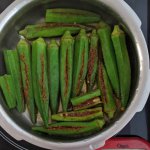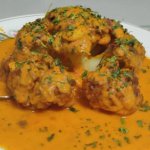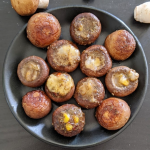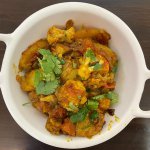Techniques – #G – Greater Surface Area





Greater surface area to maximise heat transfer:
The logic is simple. OPOS cooking is ultra fast because enormous amounts of heat is transferred to food by steam in pressure baking. Now this heat transfer is more when more surface area of food is exposed to steam. In other words, by varying the surface area, we can vary the rate of heat transfer, and thereby vary the cooking time.
Greater surface area to combat effect of cooking inhibitors:
In some cases, inhibitors slow down cooking. Most of us like our dals mushy & completely disintegrated in curries like dal tadka or sambar. This is not possible when we cook them in minutes, especially in presence of a cooking inhibitor like tamarind. So we tried out numerous hacks.
1. We tried the pot in pot technique, where dal was isolated from tamarind
2. We tried adding in the OPOS tamarind paste after cooking is over
3. We tried replacing dal with roasted and ground dal powder.
All these worked, but we needed a general solution, which can work across recipes. The very same problem is faced in Chakkara pongal, where jaggery inhibits rice from cooking.
One solution was to increase the surface area to speed up cooking and compensate for the presence of these cooking inhibitors. We started using both cereal and lentil grits in many recipes, as they are easier to cook as compared to whole grains.
Tuvar dal was whizzed in a blender for a few seconds, breaking it up into grits. These grits were sieved to remove powder and were used in place of tuvar dal. In case the grits still remain uncooked, pre-roasting/ soaking or both were proposed.
Cereal grits are common in Indian cuisine, but lentil grits are not. As grits have a larger surface area, they cook faster. In OPOS, we use grits wherever mushiness is desired. Both dal and cereal grits can be cooked to a mush – the consistency desired in many porridges/ kheers & dals.
This technique was later extended to using roasted grits and cooking them by retained heat (by just mixing them with hot water, with the stove switched off). This works well with cereal grits (rava/ rice). The recipes for upmas and kesaris is based on this principle. We have not yet cooked lentil grits with retained heat.
Lentil grits are not yet commercially available as the idea is still strange to Indian cuisine. Hopefully manufacturers will start selling roasted grits, instead of whole dals. This would greatly cut down fuel consumption and cooking time. In a country where dal is on the menu for every meal, this would mean huge savings!
Greater Surface area to balance cooking times:
In recipes like Aloo Gobi, potatoes are cooked with cauliflower. Now poatoes take a long time to cook. Cauliflower cooks in a fraction of that time. Bu we can still balance their cooking times by cutting potato small and cauliflower large. The surface area of tough-to-cook ingredients needs to be increased and that of easy-to-cook inredients to be decreased.
In recipes like Vegetable Usili, dal is cooked with vegetables. As we do not cook vegetables for over 5 minutes in OPOS, we need to ensure dal cooks within this time. We again increased the surface area of dals by soaking and grinding them to a coarse paste, which was layered over vegetables. This greater exposed area ensured the dals cook in under 5 minutes, along with the vegetables.
Lesser Surface area to balance cooking times:
The reverse needs to be one when we are worried about undesirable moisture leakage.
While roasting mushrooms, we avoid cutting them and cook them whole, to ensure a dry roasted texture. Cutting them increases their surface area and increases moisture leakage.
While using tomatoes, we try to use them whole, to minimise exposed surface area to minimise moisture leakage and maximise caramelisation. In case of large tomates, we used scooped ones, to balance cooking with caramelisation.
While using okra, we try to use them whole or cut them into big chunks. This minimises exposed surface area and prevents leakage of the slimy mucilage, which turns the whole dish slimy. We do the reverse in case of deep fried okra, where okra is cut diagonally into thin slices, to maximise surface area. This ensures more flour can stick to its surface and fry fast into a crispy treat.
In recipes like Dum aloo, potatoes are slit deep or pierced, to increase their surface area. In Gobhi Musallam, the tight head of cauliflower/ Broccoli is separated by inserting almonds, to maximise their surface area. In Murg Musallam, the thighs and drumsticks, the thickest parts of a chicken, are deeply slit, to maximise their surface area.
In almost all vegetable recipes, we ensure vegetables are not cut into big chunks, as this would really increase cooking time. We never advocate cooking whole potatoes or big chunks of food as the minimal surface area means a great increase in cooking water and fuel.
